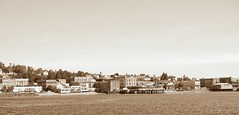Wissahickon Creek, Fairmount Park
Originally uploaded by deb5
This time I turned right and wound up in a place called Valley Green, next to a hundred and fifty year old inn (still in business), looking at Wissahickon Creek and a bridge that was rebuilt at the turn of the last century. Here's a photo (I no longer bring a camera on trips... I just go to Flickr and find what I saw in someone else's pictures. Very convenient, but unfortunately few tourists take pictures of my relatives...)
Edgar Allan Poe wrote an essay about the creek, although he seemed more interested in discussing the American sense of inferiority to Europe. (He says the Philadephians never noticed the beauty of the creek until an English woman wrote approvingly of it.)
One odd thing... the ducks and geese there begging to be fed, were quite at peace with each other. Where I live ducks and geese always seem to fight each other. But on the Wissahickon they even swam in formation together. Interspecies harmony.


